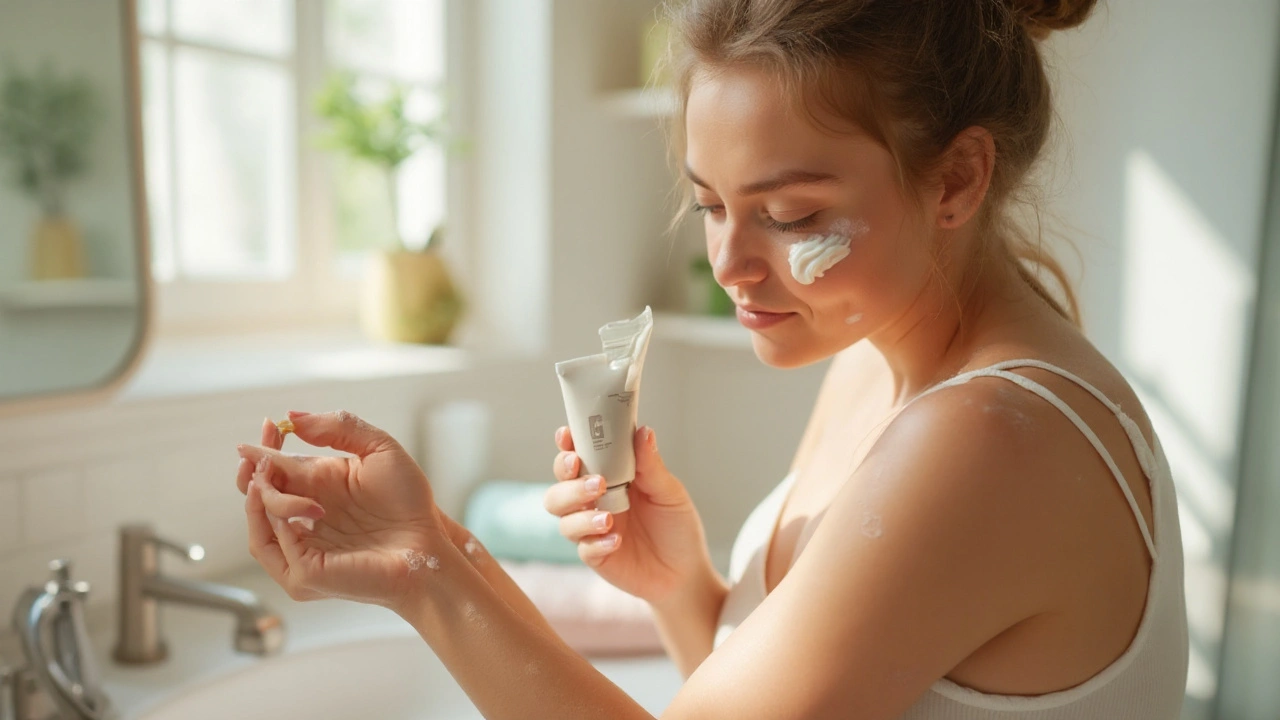
TL;DR
- Elidel is a prescription‑only cream (pimecrolimus) that calms inflammation in eczema and other minor skin irritations.
- Apply a thin layer to affected areas twice daily; no need for steroid‑strength wash‑out.
- Side effects are usually mild - burning or itching for a few minutes - but avoid use on infected skin.
- It’s safe for kids over 2years, but pregnant or breastfeeding mums should check with a doctor first.
- Compared with steroid creams, Elidel has lower risk of skin thinning but may be pricier.
What is Elidel and how does it work?
Elidel is the brand name for pimecrolimus 1% cream, a topical immunomodulator approved in Australia for treating mild‑to‑moderate atopic dermatitis (eczema) and other inflammatory skin conditions. Unlike steroid creams that blunt the immune response, pimecrolimus targets a specific pathway - it blocks the activity of calcineurin, a protein that triggers T‑cell activation and the release of inflammatory cytokines.
Think of it as turning down the volume on an over‑active immune alarm in your skin rather than shutting the alarm off completely. This selective action helps reduce redness, itching and swelling while preserving the skin’s natural barrier.
Because the drug works at a cellular level, it takes a few days for visible improvement. Most dermatologists see meaningful relief within 1‑2weeks of consistent use.
When and how to use Elidel - step‑by‑step guide
Using Elidel correctly maximises benefits and minimises irritation. Follow these steps each time you apply the cream:
- Clean the area: Gently wash with lukewarm water and a mild, fragrance‑free cleanser. Pat dry - don’t rub.
- Measure the dose: A pea‑sized amount (about 0.5g) is enough for a small patch. For larger patches, spread a thin, even layer - you want the skin to see the medication, not a greasy film.
- Apply twice daily: Morning and evening are typical. If you miss a dose, apply it as soon as you remember unless it’s close to the next scheduled time - then skip the missed one.
- Avoid occlusion: Don’t cover the treated area with airtight dressings unless your doctor says otherwise. Covering can increase absorption and raise the chance of burning.
- Wash hands: After applying, clean your hands unless you’re treating your own hands.
Things to watch out for:
- Do not use on open wounds, fungal infections or herpes‑affected skin - pimecrolimus won’t treat the infection and might worsen it.
- Stay clear of UV‑intensive activities (like beach trips) right after application; it can boost skin sensitivity.
- If you’re using another topical (e.g., steroid), wait at least 30minutes between products to avoid interference.
Benefits versus risks - what to expect
Elidel offers a few clear advantages over traditional steroid creams:
- Lower risk of skin thinning: Steroids can cause atrophy after prolonged use, especially on thin skin (face, neck). Elidel doesn’t thin the skin because it doesn’t alter collagen synthesis.
- Safe for sensitive areas: You can use it on the eyelids, genitals and other delicate zones where steroids are problematic.
- Long‑term maintenance: Because side effects are mild, many dermatologists prescribe it for intermittent maintenance - a few nights a week during flare‑ups.
On the flip side, keep these risks in mind:
- Local irritation: Up to 30% of users feel a brief burning or itching sensation when they first apply the cream. It typically fades after a few days.
- Infection risk: Suppressing the immune response can let bacterial or viral skin infections slip in. Watch for worsening redness, pus, or fever.
- Cost: As a patented product, Elidel is pricier than generic hydrocortisone. Some pharmacists offer bulk‑buy discounts; always ask.
- Pregnancy & lactation: Human data are limited. Current Australian guidelines advise a risk‑benefit discussion with your GP before starting.
Overall, most patients report a good balance of relief and tolerability, especially when steroids have caused side‑effects in the past.

Elidel compared with other eczema treatments
| Feature | Elidel (pimecrolimus) | Low‑potency steroids (e.g., hydrocortisone 1%) | Medium‑potency steroids (e.g., betamethasone valerate 0.1%) | Tacrolimus ointment (Protopic) |
|---|---|---|---|---|
| Mechanism | Calcineurin inhibitor (immunomodulator) | Anti‑inflammatory glucocorticoid | Anti‑inflammatory glucocorticoid | Calcineurin inhibitor (immunomodulator) |
| Age approved | ≥2years | All ages | ≥12years (some off‑label use) | ≥2years |
| Skin thinning risk | Low | Low‑moderate | Moderate‑high | Low |
| Typical cost (AU$ per tube) | ~$70‑$90 | ~$10‑$15 | ~$25‑$35 | ~$75‑$95 |
| Onset of relief | 5‑7days | 1‑3days | 1‑3days | 5‑7days |
| Best for sensitive areas | Yes | No | No | Yes |
The table shows why many parents opt for Elidel on their kids’ faces or diaper‑area rashes - you get a steroid‑free option with a solid safety record.
Frequently asked questions about Elidel
- Can I use Elidel on my baby’s eczema? In Australia, it’s approved for children 2years and older. For infants under 2years, doctors usually start with gentle moisturisers and low‑potency steroids.
- How long can I stay on Elidel? Short‑term courses (2‑4weeks) are common for flare‑ups. For chronic eczema, dermatologists may recommend intermittent maintenance - e.g., twice‑weekly use - as long as skin remains clear.
- Will Elidel cure my eczema? No cure, but it can keep flare‑ups under control and improve quality of life. Pair it with a good skin‑care routine: daily moisturiser, lukewarm baths, avoiding harsh soaps.
- Do I need a prescription? Yes. In Australia Elidel is Schedule4 - you’ll need a doctor’s script. Some tele‑health services can issue it after a brief assessment.
- Is there a risk of cancer? Early concerns arose from animal studies, but large human registries haven’t shown a clear link. Still, the recommendation is to use the lowest effective amount.
- Can I combine Elidel with a moisturizer? Absolutely. Apply the moisturizer first, let it absorb, then layer the thin Elidel film on top. This can reduce the burning sensation.
Putting it all together - next steps for you
If you’re thinking about trying Elidel, here’s a quick checklist:
- Schedule a consultation with your GP or dermatologist - bring a list of current skin products.
- Ask about a trial period and the best way to monitor side effects.
- Purchase a prescription‑filled tube from a reputable pharmacy; avoid online sellers without a script.
- Start with the twice‑daily routine outlined above; note any burning or redness in a diary.
- Re‑visit your doctor after 2weeks to assess effectiveness and decide on maintenance dosing.
Remember, skin health is a marathon, not a sprint. Combining Elidel with good moisturising habits, allergen avoidance and stress management often gives the best long‑term results.

Bottom line
Elidel offers a steroid‑free route to calm stubborn eczema, especially in sensitive spots where traditional creams fall short. It’s safe for kids over two, works by dialing down the immune alarm, and carries a modest irritation risk that fades quickly. By following a simple application routine and staying alert for infection signs, most users enjoy clearer skin without the downside of thinning. If cost is a concern, talk to your pharmacist about bulk pricing or a possible PBS listing. With the right guidance, Elidel can become a reliable tool in your family’s eczema‑management kit.





Crystal Newgen
September 20, 2025 AT 23:16I appreciate the thorough breakdown of Elidel's mechanism; it really helps demystify how it differs from steroids. The step‑by‑step guide is easy to follow, especially the tip about applying a pea‑sized amount. Keeping the routine consistent should make a noticeable difference over a couple of weeks.
Hannah Dawson
September 21, 2025 AT 10:56While the article is detailed, it glosses over the economic burden on families – a $70‑$90 tube isn’t trivial for many. Also, the claim that infection risk is low feels like an oversimplification; immunomodulators can mask early signs of bacterial overgrowth. A more critical look at insurance coverage would add balance.
Julie Gray
September 21, 2025 AT 22:53One must question the motives behind promoting a patented product with limited long‑term safety data. Pharmaceutical entities have historically downplayed oncogenic concerns, and the brief mention of animal studies is insufficient. Independent, peer‑reviewed surveillance is essential before endorsing widespread use.
Lisa Emilie Ness
September 22, 2025 AT 10:50Looks solid
Emily Wagner
September 22, 2025 AT 22:46From a philosophical standpoint, the skin is the body's frontier of identity, and Elidel represents a nuanced negotiation between suppression and preservation of that frontier. By inhibiting calcineurin, we avoid the brute force of steroids, opting for a more elegant modulation of the immune cascade. This aligns with the principle of therapeutic minimalism – intervene just enough to restore homeostasis. Yet, the cost factor introduces an ethical dilemma: is equitable access to such nuanced care truly attainable? Ultimately, the decision rests on a balance between biochemical precision and socioeconomic reality.
Mark French
September 23, 2025 AT 10:43Hey there, I totally get the worry about side effects – they’re usually just a brief tingling that fades quickly. Make sure you keep a diary of any burnin or redness so your doc can adjust the dose if needed. Also, always wash your hands after applying unless you’re treating ur own hands – that little step prevents accidental spread.
Daylon Knight
September 23, 2025 AT 22:40Oh great another pricey cream for skin, as if we needed more fancy stuff. Sure, it won’t thin your skin but your wallet? Yeah, that’s a different story. Guess some folks love paying extra for the same result.
Jason Layne
September 24, 2025 AT 10:36The marketing narrative surrounding Elidel is a textbook case of pharmaceutical obfuscation designed to distract from deeper regulatory failures. First, the text asserts "low risk of skin thinning" without providing quantified incidence rates, effectively burying crucial data beneath a veneer of reassurance. Second, the reliance on the phrase "large human registries haven’t shown a clear link" to cancer sidesteps the statistical power needed to detect rare events, especially when the follow‑up periods are limited. Third, the cost comparison fails to account for socioeconomic stratification, implying that price is a secondary consideration when, in reality, it drives health inequities. Fourth, the recommendation to "use the lowest effective amount" is a vague directive that lacks concrete dosing guidelines, leaving patients to rely on anecdotal trial‑and‑error. Fifth, the suggestion that "bulk‑buy discounts" may alleviate cost pressures assumes access to pharmacy networks that many rural or underinsured patients simply do not have. Sixth, the article downplays infection risk by labeling it as "local irritation" rather than acknowledging systemic susceptibility that may arise from chronic immunomodulation. Seventh, the non‑mention of potential drug‑drug interactions, especially with other calcineurin inhibitors, raises safety concerns for polypharmacy patients. Eighth, the casual dismissal of long‑term carcinogenic studies ignores the precautionary principle that should govern any immunosuppressive topical agent. Ninth, the implied endorsement of tele‑health prescriptions bypasses the critical physical examination component that can identify contraindications such as active viral lesions. Tenth, the assertion that the product is "safe for kids over two" neglects developmental pharmacokinetic variations that could alter systemic absorption. Eleventh, the article’s tone lacks the necessary scientific rigor, substituting marketing fluff for empirical evidence. Twelfth, the absence of a discussion on formulation excipients omits potential allergens that could exacerbate dermatitis. Thirteenth, the statement that "most patients report good balance" is anecdotal and unsubstantiated by peer‑reviewed surveys. Fourteenth, the reliance on dermatologist discretion without standardized treatment algorithms leads to inconsistent patient outcomes. Fifteenth, the overall narrative creates a false equivalence between Elidel and placebo, which is misleading. In sum, while the piece presents a superficially balanced overview, it systematically trims away the very details that would empower an informed consumer to weigh risks, benefits, and alternatives responsibly.
Hannah Seo
September 24, 2025 AT 22:33Happy to add a practical perspective: when you start Elidel, apply a moisturizer first and let it sink in for a few minutes – this often reduces the initial burning sensation. Keep a simple symptom log: note the time of application, any tingling, and any visible improvement; this makes follow‑up appointments more productive. If you notice any signs of infection, such as increased redness, pus, or fever, stop the cream and contact your dermatologist right away. Lastly, ask your pharmacist about generic alternatives or patient assistance programs; many insurance plans will cover a portion of the cost when a valid prescription is presented.